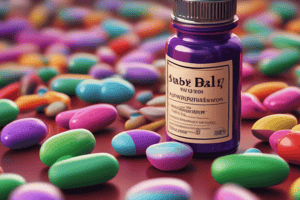Podcast
Questions and Answers
RA 10754 is an Act Expanding The Benefits And Privileges of ______.
RA 10754 is an Act Expanding The Benefits And Privileges of ______.
PWDs
Opium and its active components such as heroin and morphine fall under the category of ______ Drugs.
Opium and its active components such as heroin and morphine fall under the category of ______ Drugs.
Prohibited
Coco Leaf and its derivatives, including ______, are classified as prohibited drugs.
Coco Leaf and its derivatives, including ______, are classified as prohibited drugs.
cocaine
Self-inducing sedatives such as secobarbital and phenobarbital are considered ______ drugs.
Self-inducing sedatives such as secobarbital and phenobarbital are considered ______ drugs.
Hypnotic drugs like methaqualone can produce similar physiological effects as ______.
Hypnotic drugs like methaqualone can produce similar physiological effects as ______.
Pharmakon is a Greek word for ______.
Pharmakon is a Greek word for ______.
Pharmacology is the science that deals with the study of drugs and their actions on ______.
Pharmacology is the science that deals with the study of drugs and their actions on ______.
Therapeutic methods are approaches to ______ therapy.
Therapeutic methods are approaches to ______ therapy.
Pharmacognosy is concerned with the ______ sources of drugs.
Pharmacognosy is concerned with the ______ sources of drugs.
Pharmacy involves the preparation, compounding, and dispensing of drugs for ______ use.
Pharmacy involves the preparation, compounding, and dispensing of drugs for ______ use.
RA 6425 is known as the Dangerous Drug Act of ______.
RA 6425 is known as the Dangerous Drug Act of ______.
Toxicology studies the ______ effects that may be produced by drugs.
Toxicology studies the ______ effects that may be produced by drugs.
The Dangerous Drug Board is the policy-making body that created the Philippine Drug ______ Agency.
The Dangerous Drug Board is the policy-making body that created the Philippine Drug ______ Agency.
Flashcards are hidden until you start studying
Study Notes
Terminology in Pharmacology
- Pharmakon: Greek word for drugs.
- Logos: Means study; together forms pharmacology - the science of drug effects on living organisms.
- Therapeutic methods: Approaches to drug therapy.
- Drug Therapy: Includes treatment with drugs, dietary changes, physiotherapy, and psychological therapy.
Drugs Overview
- Droog: Dutch term meaning dry; refers to the chemical substances affecting living organisms.
- Therapeutic drugs: Medications used for disease prevention and treatment.
Branches of Pharmacology
- Pharmacognosy: Study of botanical sources of drugs.
- Pharmacodynamics: Focuses on how drugs act in living tissues, including absorption, excretion, and the body's response.
- Pharmacotherapeutics: Application of drugs for treating sick individuals.
- Toxicology: Examines the harmful effects of drugs, symptoms of poisoning, treatments, and poison identification.
Ten Rights of Drug Administration
- Right Patient
- Right Drug
- Right Dose
- Right Time
- Right Route
- Right Education
- Right to Refuse
- Right Assessment
- Right Evaluation
- Right Documentation
Philippine Drug Laws and Agencies
- RA 6425 (Dangerous Drug Act of 1972): Foundation of the Philippine Drug Law Enforcement System.
- RA 9165 (Comprehensive Dangerous Drug Act of 2002): Strengthened national anti-drug efforts and imposed heavier penalties.
- Dangerous Drug Board: Policy-making body establishing the Philippine Drug Enforcement Agency (PDEA).
- RA 3720: Ensures safety, efficacy, and purity of food and drugs (FDA).
- RA 9502: Cheaper and Quality Medicines Act.
- RA 6675: Generics Act of 1988.
- RA 5921: Pharmacy Law.
- Other relevant acts include RA 7394 (Consumer Act), RA 7581 (Price Act), RA 8172 (Asin Law), and more.
Drug Classification
-
Prohibited Drugs:
- Opium and derivatives (heroin, morphine).
- Coca Leaf and derivatives (cocaine).
- Hallucinogenic drugs (LSD, mescaline).
- Indian hemp and its derivatives.
- Drugs with narcotic or hallucinogenic effects, natural or synthetic.
-
Regulated Drugs:
- Self-inducing sedatives (barbiturates).
- Amphetamine isomers (e.g., benzidrine, Dexedrine).
- Drugs with effects similar to amphetamines.
- Hypnotic drugs (methaqualone, nitrazepam).
Studying That Suits You
Use AI to generate personalized quizzes and flashcards to suit your learning preferences.


